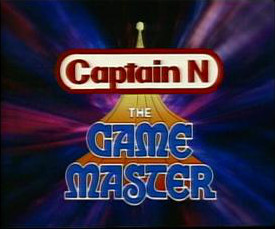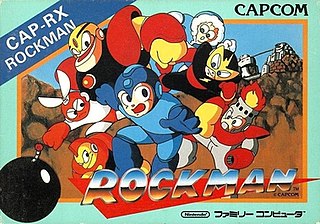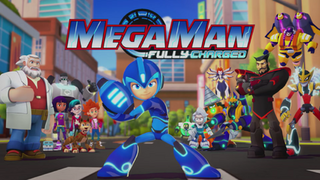
Adventures of Sonic the Hedgehog is an animated series based on the Sonic the Hedgehog video game series, produced by Sega of America, DIC Animation City, Bohbot Entertainment and the Italian studio Reteitalia S.p.A. in association with Spanish network Telecinco. Airing during the fall of 1993, 65 episodes were produced. It was syndicated by Bohbot Entertainment in the United States.
Bob and George was a sprite-based webcomic which parodied the fictional universe of Mega Man. It was written by David Anez, who was a physics instructor living in the American Midwest at the time. The comic first appeared on April 1, 2000, and ran until July 28, 2007. It was updated daily, with there being only 29 days without a comic in its seven years of production and with 2568 comics being made altogether.

Mega Man 5 is a 1992 action-platform game developed by Capcom for the Nintendo Entertainment System. It is the fifth game in the original Mega Man series and was released in Japan on December 4, 1992. It saw a release during the same month in North America and in 1993 in Europe.

Mega Man & Bass is a 1998 action-platform game developed and published by Capcom. It is a spin-off game in the original Mega Man series and was originally released in Japan for the Super Famicom on April 24, 1998. It was later ported to the Game Boy Advance (GBA) handheld in 2002, and localized in English and released the following year.

Captain N: The Game Master is an animated television series that aired on NBC from 1989 to 1991 as part of its Saturday morning cartoon lineup. Produced by DIC Animation City, it incorporated elements from video games of the time by Japanese company Nintendo. There was also a comic book adaptation by Valiant Comics.

MegaMan NT Warrior is an anime and manga series based on the Mega Man Battle Network series by Capcom, both using the same name but heavily diverging from each other in terms of plot. The manga series was written by Ryo Takamisaki and ran in Shogakukan's CoroCoro Comic between 2001 and 2006, while the anime television series, produced by Xebec, Nihon Ad Systems and TV Tokyo, ran for five seasons on TV Tokyo in Japan between March 2002 and September 2006, reaching 209 episodes in total, as well as a feature film. Viz Media would license the series for distribution in North America, including all the main chapters of the manga between 2004 and 2008, while the anime would only have its first season and Axess aired on Kids' WB! from 2003 to 2005.

Mega Man 8 is a 1996 action-platform game developed and published by Capcom. It was directed by Hayato Kaji and produced by Keiji Inafune, both of whom had previously worked on the series as artists. It is the eighth installment in the original Mega Man series, and was initially released in Japan on the PlayStation in 1996. The following year, Mega Man 8 saw a release on the Sega Saturn and was localized for both consoles in North America and the PlayStation alone in PAL regions. Mega Man 8 is the first game in the series made available on 32-bit consoles. The plot follows series protagonist Mega Man as he is called to investigate an energy reading coming from a recent meteor crash on an island. Mega Man discovers that his nemesis Dr. Wily has run off with the energy source, and sets off to stop Wily's evil plans to use the energy, and to discover the purpose of a mysterious alien robot found at the crash site.

Mega Man, known as Rockman in Japan, is a 1987 action-platform game developed and published by Capcom for the Nintendo Entertainment System. It was directed by Akira Kitamura, with Nobuyuki Matsushima as lead programmer, and is the first game of the Mega Man franchise and the original video game series. Mega Man was produced by a small team specifically for the home console market, a first for Capcom, which previously focused on arcade video games.

Extreme Dinosaurs is an American animated series produced by DIC Productions, L.P. and Bohbot Entertainment in 1997 based on a 1996 toy line from Mattel. This show is a spin-off of Street Sharks.

Mega Man Powered Up is a 2006 action-platform game developed and published by Capcom. It was released for the PlayStation Portable (PSP) handheld game console in March 2006. It is a remake of the original Mega Man game released in 1987 for the Nintendo Entertainment System (NES). Players control the eponymous star Mega Man who must stop Dr. Wily from conquering the world using eight robots called Robot Masters. Unlike the original game, players can control these eight Robot Masters under the right circumstances. Other new features include a level creator mode and a challenge mode.

Mega Man 9 is a 2008 action-platform game developed by Capcom and Inti Creates. It is the ninth numbered game in the original Mega Man series, and the first home console game in the series since Mega Man & Bass (1998). Mega Man 9 was the first game in the series not to have a physical release, and was initially released only on the downloadable gaming services WiiWare, PlayStation Network (PSN), and Xbox Live Arcade (XBLA). In June 2017, it was announced that Mega Man 9 and 10 would have a physical and digital release with their inclusion in Mega Man Legacy Collection 2 for PlayStation 4, Windows, and Xbox One, as well as the Nintendo Switch in May 2018.

The Protomen, colloquially referred to by fans in retrospect as Act I, is the debut album release by indie rock band The Protomen. It is a rock opera loosely based on the Mega Man video game series, and the first volume of a planned trilogy of albums on this theme. The follow-up, Act II: The Father of Death, a prequel to The Protomen, was released on September 8, 2009.

Mega Man, known as Rockman in Japan, is the title character and the protagonist of the Mega Man series by Capcom. He was created by Akira Kitamura for the first Mega Man game released in 1987, with artist Keiji Inafune providing detailed character artwork based on Kitamura's pixel art design.

Mega Man 10 is a 2010 action-platform game developed by Inti Creates and Capcom. It is the tenth main entry of the original Mega Man series. The game was released as a downloadable title for the console gaming services WiiWare, PlayStation Network (PSN), and Xbox Live Arcade (XBLA) during March 2010. The game was also given a physical release along with four other Capcom titles from different franchises in the Capcom Essentials Pack for PlayStation 3 and Xbox 360. It was later released again for a physical and digital release as part of Mega Man Legacy Collection 2 alongside Mega Man 7, Mega Man 8 and Mega Man 9 for the PlayStation 4, Windows, and Xbox One, as well as the Nintendo Switch in May 2018.

Mega Man: Upon a Star, known in Japan as Rockman: Hoshi ni Negai o, is a Japanese anime original video animation (OVA) series based on the popular Capcom video game franchise Mega Man, produced by Universal Multimedia Entertainment, Capcom and Ashi Productions. The OVA was presented by the Japan Center for Intercultural Communications, and acts as a series of educational shorts on the culture of Japan. The episodes were produced circa 1993-94 and wouldn't be released to home media up until a Japanese DVD release by Capcom on September 20, 2002, followed by a release in North America by ADV Films on January 4, 2005, although the order of episodes 1 and 2 from the Japanese release was switched for this release. It loosely adapts the events of Mega Man 5 along with original story elements.

Mega Man 7 is a 1995 action-platform game developed and published by Capcom for the Super Nintendo Entertainment System. It is the seventh game in the original Mega Man series. The game was released in Japan on March 24, 1995 and was localized later in the year in North America and Europe.

Mega Man is a comic series produced by Archie Comics based on the video game series of the same name by Capcom. It was announced at New York Comic Con 2010, and the series began publication in April 2011 with Ian Flynn, who has written many stories for Archie's Sonic the Hedgehog series, as its lead writer. The series proved highly successful, and in 2013 a crossover took place between the Mega Man and Sonic series, under the title "Worlds Collide". The series does not follow the events of the games in exact order, including an adaptation of the Japanese exclusive game Super Adventure Rockman between those of Mega Man 2 and Mega Man 3. The series later included a few stories set in the time of the Mega Man X series. The popularity of Worlds Collide subsequently led to a second crossover with the Sonic series, Worlds Unite. The series was put into an "indefinite hiatus" after issue 55, concluding with setup for an adaptation of Mega Man 4.

Mega Man: Fully Charged is an animated television series based on the Japanese video game series of the same name published by Capcom. The series was developed by Man of Action Studios and produced by Dentsu Entertainment USA and DHX Studios Vancouver for Cartoon Network and Family Chrgd. It is the fourth television series based on the franchise, and the second to draw inspiration from the "Classic" series after the 1994 cartoon. It premiered in the United States on August 5, 2018, after the first ten episodes were first released on-demand on August 3.

Mega Man 11 is a 2018 action-platform game developed and published by Capcom. The game is an 11th main entry in the original Mega Man series, and was released worldwide for Nintendo Switch, PlayStation 4, Windows, and Xbox One in October 2018. The game was ported to Amazon Luna on September 9, 2021. The game brings back several features such as voice acting and a 2.5D graphic style from previous games throughout the Mega Man franchise.


















